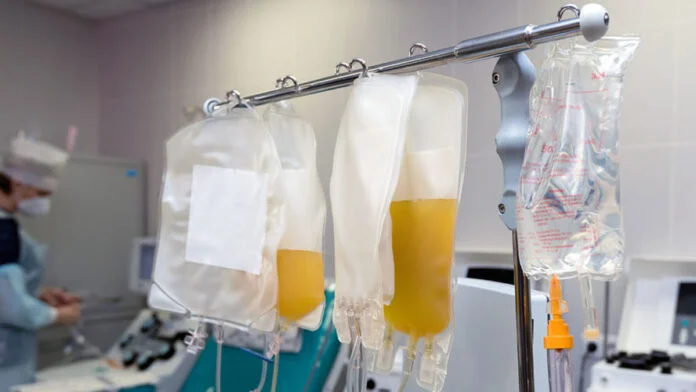The global plasma derived therapy market size was valued at USD 21 billion in 2023, driven by the increasing prevalence of chronic and rare diseases across the globe. The market size is anticipated to grow at a CAGR of 6.9% during the forecast period of 2024-2032 to achieve a value of USD 38.3 billion by 2032.
Plasma Derived Therapy: Introduction
Plasma-derived therapy refers to the use of plasma or plasma-derived products for therapeutic purposes. Plasma, the liquid portion of blood, contains a diverse range of proteins, antibodies, and other bioactive substances that can be isolated and used for medical treatments. Plasma-derived therapies have been developed to address various medical conditions and disorders. Plasma-derived therapy has revolutionized the treatment of various medical conditions by providing essential proteins and bioactive substances that are deficient or malfunctioning in patients. These therapies have significantly improved the quality of life for individuals with immune deficiencies, bleeding disorders, and other conditions.
Plasma-derived therapies have a wide range of therapeutic applications. They are used to treat immune deficiencies, autoimmune diseases, bleeding disorders, genetic deficiencies, neurological conditions, and other medical conditions where specific proteins or bioactive substances are deficient or malfunctioning.
Key Trends in the Plasma Derived Therapy Market
Key trends in the plasma-derived therapy market include:
• Increasing Demand for Plasma-Derived Products: There is a growing demand for plasma-derived products due to their efficacy in treating various medical conditions. The increasing prevalence of immune deficiencies, autoimmune diseases, bleeding disorders, and genetic deficiencies drives the demand for therapies that utilize plasma-derived proteins and bioactive substances.
• Advancements in Fractionation Technologies: Continuous advancements in fractionation technologies have led to improved efficiency and yield in the production of plasma-derived products. Newer methods, such as chromatography, have enhanced the purification process, resulting in higher product purity and reduced risk of contamination.
• Growing Awareness and Diagnosis of Rare Diseases: There is a greater awareness and diagnosis of rare diseases, many of which can be treated with plasma-derived therapies. As the understanding of these conditions improves, the demand for plasma-derived products specifically developed for rare diseases is expected to increase.
• Development of Recombinant Alternatives: The development of recombinant technologies has led to the production of recombinant alternatives to plasma-derived proteins. These recombinant proteins offer advantages such as increased scalability, reduced risk of viral contamination, and potential cost savings.
• Increasing Regulatory Scrutiny: Regulatory agencies are placing greater emphasis on the safety, quality, and traceability of plasma-derived products. Stricter regulations and guidelines are being implemented to ensure the safety of donors, prevent the transmission of infectious diseases, and maintain product quality throughout the manufacturing process.
Plasma Derived Therapy Market Segmentations
The market can be categorised into product, application, and region.
Market Breakup by Product
• Immunoglobulin
• Coagulation factors
• Albumin
• Others
Market Breakup by Applications
• Haemophilia
• Primary immunodeficiency disease
• Idiopathic thrombocytopenic purpura
• Others
Market Breakup by Region
• North America
• Europe
• Asia Pacific
• Latin America
• Middle East and Africa
Plasma Derived Therapy Market Overview
The plasma-derived therapy market has been experiencing significant growth in recent years. Factors contributing to this growth include the increasing prevalence of chronic and rare diseases, advancements in plasma collection and fractionation technologies, and the expanding application areas of plasma-derived therapies. Plasma-derived therapies play a crucial role in the treatment of rare diseases. As the awareness and diagnosis of rare diseases improve, the demand for plasma-derived products specifically developed for these conditions is expected to rise.
The plasma-derived therapy market is competitive, with several established players and a growing number of emerging companies. Key industry participants include pharmaceutical companies, plasma collection centers, and fractionation plants. Companies engage in research and development activities to develop new plasma-derived products and improve existing therapies. The demand for plasma-derived therapies is rising not only in developed regions but also in emerging markets. Factors such as increasing healthcare expenditure, improving healthcare infrastructure, and greater access to medical treatments contribute to the growth of plasma-derived therapy markets in these regions.
Key Players in the Plasma Derived Therapy Market
The key features of the market report include patent analysis, grants analysis, clinical trials analysis, funding and investment analysis, partnerships, and collaborations analysis by the leading key players. The major companies in plasma derived therapy market are as follows:
• CSL Behring
• Takeda Pharmaceutical Company Limited
• BPL
• ADMA Biologics
• Biotest AG
• Octapharma
• Grifols
• Kamada Pharmaceuticals
• SK Plasma
• Kedrion

